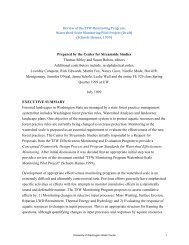Copyright 2012 Aileen M. Echiverri-Cohen - University of Washington
Copyright 2012 Aileen M. Echiverri-Cohen - University of Washington
Copyright 2012 Aileen M. Echiverri-Cohen - University of Washington
You also want an ePaper? Increase the reach of your titles
YUMPU automatically turns print PDFs into web optimized ePapers that Google loves.
iomarker approach may elucidate mechanisms underlying inhibitory therapeutic change and<br />
identify components for the development <strong>of</strong> more targeted interventions.<br />
Several limitations are worth noting. The sample size for the present study was small.<br />
Large effects were observed but they may potentially be not stable, thus merit replication in<br />
larger samples. There was no control condition in the present study, therefore does not permit the<br />
isolation <strong>of</strong> the effects from pre- to post-treatment beyond time. However, the design was<br />
designed to specifically examine differential treatment effects between PE and SER. Related to<br />
this, other comparison groups (other inhibition-related disorders) that might be expected to show<br />
similar modulations in inhibition were not included and thus it is unknown whether the pattern <strong>of</strong><br />
findings are specific to PTSD or not. Also, conclusions can only be made on the short-term<br />
effects <strong>of</strong> these treatments and cannot speak to the long term, maintenance <strong>of</strong> symptom<br />
improvement. It also remains to be determined whether the inhibitory deficits existed prior to<br />
PTSD or whether it developed with the disorder. Although multi-level modeling analytic<br />
methods do not require complete data on all participants on all outcome measures, these analytic<br />
methods assume the missing data is missing at random (MAR). MAR assumes that the<br />
missingness is not related to the outcome. In the case where missingness is information (i.e., not<br />
randomly missing), the robustness <strong>of</strong> the analytical results may be in question. Future research<br />
may assess potential informativeness <strong>of</strong> the missing data with methods such as the pattern-<br />
mixture model approach (Hedeker & Gibbons, 1997). Finally, AB and PPI are theoretically<br />
indexes <strong>of</strong> inhibition, however, are also affected by other functions (e.g., vigilance, attention)<br />
and as such the role <strong>of</strong> other functions cannot be ruled out. Similarly, the construct validity <strong>of</strong><br />
commonly used inhibition tasks, including AB, are not yet well established (Friedman &<br />
48
















